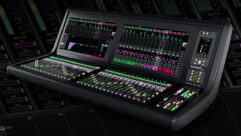RACK & DON’T ROLL
Jul 1, 2001 12:00 PM,
BY BOB SCHLUTER
Seismic rating is a major consideration when integrating and installing equipment racks
EARTHQUAKES ARE NOT LIMITED TO THE STATE OF California or the Discovery Channel. Nor are they infrequent; seismic events take place every day throughout much of the continental western United States. When combined with all the seismic activity that occurs around the world, scores — sometimes hundreds — of earthquakes take place each day over a wide range of Richter values. It’s only the big ones that make the front pages.
Others faults have as much if not more kinetic potential than the widely known San Andreas Fault in California. In fact, records indicate that the New Madrid Fault (through parts of Missouri, Tennessee and Illinois) actually changed the course of the Mississippi River when a slip in the fault produced a massive earthquake in the 19th century. Residents of New York City, proud of its deep bedrock foundation, were surprised to read in the papers one morning this year that Manhattan had experienced its own temblor the previous day.
The amount of seismic activity going on all around us every day is quite remarkable. No one needs to be more aware of this fact than professionals who design, specify and install racks of equipment for audio, video, data and multimedia presentations. Those responsible for every type of structure — from sophisticated restaurants with multizone music programs and house video to mega-stadiums where computer-based multimedia systems run everything — need to understand the minimum standard requirements to keep the systems up, running and safe in the event of significant seismic activity. In many instances, millions of dollars worth of technology depends on the quality of the racks it is stored in for its continued viability after Mother Nature gets riled.
CODIFYING SEISMIC RISK
All facilities classified as essential (i.e., fire and medical structures, police facilities, critical government agencies) have to be seismically rated. Since those same facilities also require internal audio, video and data intercommunication, systems designers are increasingly interfacing with the architects and engineers who create and renovate such facilities. In addition, even facilities that don’t fall into this classification, so-called non-essential structures, are implementing more highly sophisticated — and expensive — audio, video and data gear whose electronics would benefit greatly from the overall higher level of protection offered by seismically rated racks or enclosures.
The guidelines for such ratings are derived from two sets of specifications established by independent organizations. The 1997 Uniform Building Code is a refinement of a UBC specification created in 1994. The earlier version was relatively general in scope and broadly divided the U.S. into four zones, of which Zone 4, comprising most of central and coastal California, was rated the most prone to earthquake activity. See “Know Your Building Codes.”
The other standard, the 2000 International Building Code, is considerably more precise: In addition to viewing the entire continent as a series of potential seismic locations, the specification has resulted in maps that measure a given location’s potential for experiencing seismic activity relative to an identified fault, along with probability maps for every 100-foot section relative to the fault’s location. This enables seismologists to determine the “S factor” for a location — the likelihood that it will experience seismic activity.
The two code specifications are different in philosophical approach but are ultimately complimentary in practice; the IBC is, in essence, a more refined view of the UBC. While the UBC, as it was originally developed, was somewhat rigid in its application, it did provide the basis for the calculations that determine a structure’s rating. The IBC specification allows the output of these calculations to be more precisely applied to physical structures, taking into account geographical situations and other factors. This information, along with historical information about the severity and duration of previous seismic events, enables physical engineers and architects to determine the level of seismic resistance that equipment racks will require.
SPECIFY THE RIGHT RACKS
The project engineer involved in the design and construction of a facility is responsible for determining the rating of the facility, because the rating is applied to the structure itself (which is viewed as a system with numerous components). That observation then becomes part of the specifications of the bid put out for the job. But note that it is the A/V or multimedia systems designer/installer who is responsible for assuring that the enclosures and racks are ones that comply with any seismic specifications that the engineers and architects have laid out.
How do you know if racking will withstand the seismic activity? It should come already evaluated, rated and certified for seismic applications. Certified test results will let you know if the equipment will stand up to a large tremor. Many pieces are designed to withstand the highest recordable seismic activity in an essential-facility environment with up to 1000 pounds of equipment uniformly distributed in the racks. That’s why biding on projects that have significant seismic implications need not be intimidating. There are products made to meet seismic challenges.
It’s because some systems integrators are intimidated when a job needs to be seismically rated that manufacturers need to provide enclosure systems seismically rated as standard and offer support throughout the entire installation process.
SAFE AND SUCCESSFUL
The tests underscore two critical aspects of racks in a seismic situation: installation of the racks — more precisely, the interaction of the rack and the physical plant of the building — and how equipment is distributed within those racks. Both of these considerations will have significant effects upon the performance of the racks and enclosures under stress.
Anchor the Rack
To achieve maximum protection for equipment in the rack, and to comply with the code specifications outlined by the IBC and UBC, the rack itself needs to be properly and firmly anchored to the facility floor. In choosing fasteners, the type of flooring first needs to be determined (concrete, wood, etc.). Choose the quality of fastener with the same degree of care you would any critical component of a system. Fasteners with high shear rating and high tensile strength are the best choice. Quality fasteners, combined with proper installation, create a synergy between the rack and the physical structure around it.
Though not as critical as the floor anchors, anchoring the top of the rack is also important. There are additional efficiencies you can achieve here. For instance, if you anchor the top of a rack or enclosure to the sidewall using a cable ladder, it reduces the tension load on the floor anchors.
Rear Support
Other specifications determine how and to what extent a component within the rack or enclosure requires rear support. A unit must be rear-supported if all of the following criteria apply:
- The unit exceeds 10 pounds per rack space.
- It has a rear center of gravity.
- The overall depth of the unit is greater than 2.5 times the racking height.
In addition, rear support is required if the rackmounting ears of an individual piece of equipment are incapable of cantilevering the weight of the unit. If the unit flexes when it is pushed down or when the rear of the unit is lifted, rear-hanging or blocking will prevent the equipment from whipping during a seismic event.
Stacking the Rack
The trend over the last several years has been toward deeper, shorter components as more digital audio and video processing gear, which tends to be lighter and more compact than its analog predecessors, has come to the market. As systems evolve, system weight is being redistributed. Racking has to keep pace with that evolution.
We discussed center of gravity before. This is also crucial to maximizing the rack’s protective potential and its resistance to seismic volatility. Keeping the center of gravity as low as possible puts less strain on the footing and wall anchors. Thus, heavy equipment such as amplifiers must be placed at or near the bottom of the rack. The rule of thumb is: the heavier the individual piece of gear relative to all the other equipment, the lower the placement.
In short, to be seismically ready, a rack should always be filled from bottom to top; and no rack space should be left unfilled with either equipment or a blank rack panel, as gaps take away from the support.
Keeping in Shape
During the assembly and installation of racks and enclosures, ensure that all of the fasteners — both those fastening the enclosure system to the physical plant and the rack screws — remain tight. The fundamental reason for this is to make sure that the rack is assembled and remains square — even if it’s assembled off site (one of the collateral benefits of a seismic design is that it travels well) so that the torsion due to travel or misplaced weight does not distort this shape.
When the rack is properly squared, all of the side-to-side motion that a rack system will experience in an earthquake will travel right down to the floor. In fact, in a well-bolted enclosure system, the floor (and, to a lesser extent, the walls) actually become part of the enclosure system, and vice versa. This adds exponentially to the survivability of an enclosure system, even in the most severe seismic events. It’s also suggested that the enclosure system’s plumb be checked at installation.
These are some of the major considerations when choosing the rack system for the seismic circumstances at your facility. The most important thing to keep in mind is that any system will only perform as well as its weakest link. Racking may not be as glamorous or as technically fascinating as the equipment that the racks will hold, but it is the first line of defense that will keep that equipment — and the client’s business — working without interruption in the event of a 7.0 earthquake. Dollar for dollar, proper rackmounting is the best insurance a facility can buy.
Bob Schluter is president of Middle Atlantic Products Inc. A multiple-patent holder, he has been active in the professional audio business since 1976 and has been involved in adapting rack enclosures to accommodate rapidly changing technology.
Rack Types
Having an array of rack type choices is very desirable. Depending upon the type and amount of equipment, an installer may want a rack design that offers good capacity and allows significant space for cable management. Smaller areas benefit from racks designed for higher density storage.
If you adhere to all the seismic guidelines, you can even certify racks that are designed to pull out to allow rear access to racked equipment — very useful as equipment gets more complex and has to be reconfigured more often.










